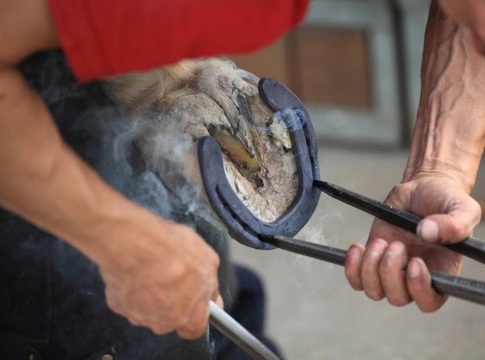
The Role of the Farrier in Hoof Care
A lot can go wrong with a horse's hooves as many an owner often find out. From sand cracks to an abscess forming and lots of injuries in-between, there are wounds to the sole or even just a bruise that can cause a whole of hoof problems which a farrier can help you with.
The role of the farrier is crucial when it comes to finding out the root cause of a hoof problem and they can also advise on the best way to make things better and more comfortable for your horse sooner rather than later.
Apart from being able to spot there might be a problem, the farrier plays a vital role when it comes to keeping hooves the correct shape by regular trimming and shoeing. It's the farrier who recommends the best type of shoe to use on your horse which is not as easy as it may sound because some horses need to wear specific shoes whereas others don't. This is particularly true if a horse has 'odd' shaped feet which many of them do.
When things are not right with a horse's feet, the farrier along with your vet, is the person to ask for advice and a lot of the time, they are the ones who see there may be a problem not only with a horse's feet, but often with the lower leg too which includes the first signs of a splint forming.
What Qualifications Do Farriers Need?
In the UK, all farriers have to spend time as an apprentice with an approved and fully qualified blacksmith before they are allowed to work on their own. This is the only way they would be eligible to be part of the register of Farriers of Great Britain. The length of time a person spends as an apprentice with an ATF – Approved Training Farrier, will be enough for them to achieve all the necessary certificates that would allow them to set themselves as independent farriers.
All this training offers horse owners the sort of peace of mind they need when it comes to allowing a farrier to not only trim and shoe their horses, but for them to recommend specialist shoeing when there is a hoof problem that needs addressing. With this said, a farrier would always work alongside a vet when a horse has a serious hoof problem that needs to be dealt with.
A Farrier & Vet Work Together
When there is a serious hoof issue that needs to be taken care of, the farrier will work together with a vet to make sure the correct treatment is given to the horse so they are made to feel more comfortable and to ensure the problems is resolved as quickly as possible.
The real difference between a vet and a blacksmith when it comes to treating a hoof problem, is that your farrier would be able to identify the issue and they would be able to carry out corrective trimming and shoeing, but they would not be able to offer a diagnosis or recommend a treatment for lameness because this role falls to a vet who has received all the formal veterinary education needed to offer a diagnosis which would be followed up by a specific treatment.
It is only the vet who would be able to prescribe any sort of pain killer as well. However, your farrier would certainly be able to let you know when you would need to call out a vet if you are at all unsure of what would be best to do which is something always worth bearing in mind.
The Cost
Overall, most farriers charge pretty much the same rate for trimming and shoeing a horse's feet, although is some parts of the country this can be quite a bit higher than others. Some farriers offer specialist shoeing which also costs a lot more than normal shoeing and very often, this is when they work closely with a vet to get a horse's feet the right shape, angle and basically in better condition.
Communicating Well with a Farrier is Crucial
It's really important to communicate well any issues or concerns you may have over the condition of a horse's feet. This helps farriers because they are then able to keep an eye out for any problems when they are trimming and shoeing a horse's hooves.
Catching a stone bruise early not only means a horse would be made to feel more comfortable on their feet sooner rather than later, but it could save you a fortune in vets bills if a farrier can dig out the sole before a massive abscess starts to form in the foot and which could not only cause a lot of pain, but take a lot longer to heal too.
The same can be said of other common hoof problems like a sand crack and even the early signs of laminitis which a farrier would be able to pick up on when they have to trim or shoe a horse for you.
Conclusion
Owning a horse is a real pleasure, but along with all the good things comes a lot of responsibility. This includes having a capable and friendly farrier on board who will make sure your horse's feet are kept in great shape and condition. The role of a good blacksmith is vital in so many other ways too because it's often the farrier who picks up on a hoof problem first and the earlier it's deal with, the sooner your horse is made to feel more comfortable on their feet.



